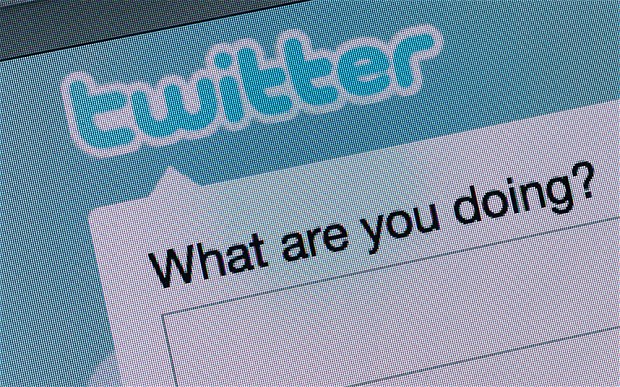Social networking sites like Twitter, Facebook or Pinterest, are populated by a very narrow section of society, scientists warn 
© AlamyTwitter trends do not represent what the public actually cares about, scientists warn.
Social networking sites like
Twitter and Facebook should not be used to gauge human behaviour or trends because they are too biased, scientists have warned.
Increasingly, social researchers and media organisations use sites to glean information about public views and interests. But computer scientists at McGill University in Montreal and Carnegie Mellon University in Pittsburgh warn that the data omits the opinion of large portions of the population who are either under-represented, or who choose not to engage in social media.
They claim the sites 'misrepresent the real world.'
One of the major problems with sites like Twitter, Pinterest or Facebook is 'population bias'
where platforms are populated by a very narrow section of society.Latest figures on Twitter suggest that just five per cent of over 65s use the platform compared with 35 per cent for those aged 18-29. Similarly far more men use the social networking site than women.
Instagram has a particular appeal to younger adults, urban dwellers, and non-whites.
In contrast, the picture-posting site Pinterest is dominated by females aged between 25 and 34. LinkedIn is especially popular among graduates and internet users in higher income households.
Although Facebook is popular across a diverse mix of demographic groups scientists warn that postings can be skewed because there is no 'dislike' button. There are also more women using Facebook than men, 76 per cent of female internet users use the site compared with 66 per cent of males.
"A common assumption underlying many large-scale social media-based studies of human behaviour is that a large-enough sample of users will drown our noise introduced by peculiarities of the platform's population," said lead author Derek Ruths, an assistant professor in McGill's School of Computer Science.
"These sampling biases are rarely corrected for, if even acknowledged."
The researchers also claim that the way in which sites direct people to links also leads to interest bias. The design of a platforms can dictate how users behave and, therefore, limit what behaviour can be measured.
And a large number of spammers and bots, which masquerade as normal users on social media, get mistakenly incorporated into measurements and predictions of human behaviour.In recent years, studies have claimed the ability to predict everything from summer blockbusters to fluctuations in the stock market through social media. Some researchers say it is possible to map the spread of disease.
But the computer scientists claim the flaws in big data sets for research could have 'huge implications.' Thousands of research papers each year are based on skewed information taken from social media, they claim.
"Many of these papers are used to inform and justify decisions and investments among the public and in industry and government," says assistant Professor Ruths.
Co-author Juergen Pfeffer of Carnegie Mellon, added: "People want to say something about what's happening in the world and social media is a quick way to tap into that. You get the behaviour of millions of people -- for free.
"Not everything that can be labelled as 'Big Data' is automatically great."
The research was published in the journal
Science.
Reader Comments
that Anna Quindlen did a column on this and her response exactly dovetailed with how I felt: she said she had a face book page (social pressure on a public figure) and let her children post on her page (aware of the dangers of allowing children their own postings).
I see this as yet another JoeCamel type of media misuse.
to report on all of the important events around the world each day because of some political/commercial agenda, you get hampster bottoms and honey boo boo disguised as news.
Sucking data from FB upon which to base the future of your business marketing scheme would be as dangerous as assuming all white women look and act like Miley Cyrus...Oh, wait
Sorry computer scientists.
A lifetime of heinous and subversive activity in the artificial intelligence industry (aka the WAR-ROOM) is not to be undone by a mere 'change of heart', as death draws near.
Let me put it to you this way: Suppose that 'Adam Lanza' (one of your computer simulations) was actually real and actually did kill those kids.
Do you think he could suddenly drop his guns (or his pants) and walk away, saying, 'School kids really deserve better than this,' and then go get a Happy Meal over at McDonalds, along with the survivors?
Hell of a party, big guys.
Have another drink.
ned, out
Seriously? They've just discovered that NOW? I mean, what else are US intelligence services going to use to 'support' stupid claims that the Russians shot down a commercial airliner, and how else are they going to both monitor and manipulate public opinion. I mean.... Duh!
Did anyone else find this curious that the UK branch of the MSM is being used to reveal this? Everyone who isn't under the age of 20 knows that broad public opinion isn't to be found on Facebook. So what does the MSM mean by admitting it at this late stage when even though we knew that any opinions taken from FB would be skewed toward the younger population, we allowed them to use the data anyway?
This revelation retroactively calls into question all of the bullshit polls and surveys and other "data" that they claim to have gotten from FB. So what would they gain from revealing this information at this particular time? What is about to happen that this becomes pertinent information that we are allowed to see?